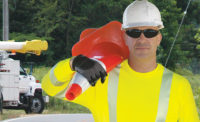Most people today are using Bluetooth technology (also known as Bluetooth Low Energy or BLE) in their daily lives. Bluetooth is embedded in many of our favorite consumer products and does a great job of making our lives more convenient and efficient. It’s likely that your car, computer, smartphone and entertainment center all employ Bluetooth technology to wirelessly transmit information. Just walking around town, you’ll notice people talking on headsets, listening to music as they run and exercise, or checking their daily fitness stats on their wearable fitness tracker, all using Bluetooth. It’s simply a part of our everyday lives!
While everyone is familiar with some of the devices mentioned above, you may not be quite as familiar with Bluetooth beacons. Beacons are being used at ballparks, malls and museums, and to provide useful information to patrons using an app on your smartphone.
So how can this technology apply to our work lives? Specifically, how can beacons be used in our careers as safety professionals to keep workers safe from dangers on the job?
As gas detection monitor manufacturers build new instruments, we are seeing many forms of wireless technology being added directly into the monitors. By incorporating Bluetooth technology into a gas monitor, the monitor can now pick up signals from beacons placed in industrial settings to add critical pieces of information to data log records, shape operator behavior, and prevent unauthorized use of equipment and access to restricted locations.
How Bluetooth beacons can answer the “where?”
Often as safety professionals we look back at alarm events and data log information to find that an operator was exposed to higher levels of a toxic gas. As we dig further into the data we see that the alarm condition persisted for several minutes.
Why were they in that condition for so long? And where were they?
If we are lucky enough to have the monitor assigned in the software to a particular user, we can go back and ask them where they were. Unfortunately, it is usually the case that the operator may not remember where they were at 10:07am on Monday the 12th. Here is where the beacons can fill in the gaps. Beacons for industrial applications can be used in hazardous areas, can be set up in minutes, can run up to four years continuously on a couple of batteries, and can provide invaluable data as to where an alarm condition occurred.
How are Bluetooth beacons deployed in an industrial facility?
Beacons are placed throughout an industrial facility or unit within the facility and each configured to a distance from one to 30 meters. As an operator with a compatible gas monitor walks through the area, the monitor sees the various beacons and determines, based on signal strength, if it is within the predefined distance of the beacon. If it is, it tags the monitor’s data log with the name of that beacon. No operator actions are needed. For example, an operator walks within 20 feet of the beacon at Separations Tank 4 (Sep Tank 4), the monitor sees several beacons in the area, but it quickly realizes that based on the signal strength from this particular beacon, it is within the beacon’s predefined distance and sets the monitor’s “Site” to “Sep Tank 4.”
A day later, as the alarm information is reviewed, it can be seen that four operators experienced high SO2 alarms in the area of Sep Tank 4. This tank is scheduled to be taken offline for maintenance in several weeks, but perhaps this maintenance timetable needs to be accelerated.
How do we move beyond “where we were” to “where we shouldn’t be?”
In addition to beacons being a valuable tool to let us know where alarms are occurring within a facility, they can also be valuable to ensure that untrained personnel are not gaining access to areas of the facility where they should not be. Since beacons know if an operator with a monitor is within a specified distance of it, it can send the monitor into alarm if an operator without sufficient permission has entered an area. This proximity alarm feature ensures that everyone within an area has the proper training and is authorized to be in that area.
As you can see, some of the Bluetooth technology that has become so commonplace in our personal lives is quickly moving into our lives at work. However, this technology at work goes well beyond making our day more fun and productive, it makes our day safer!



